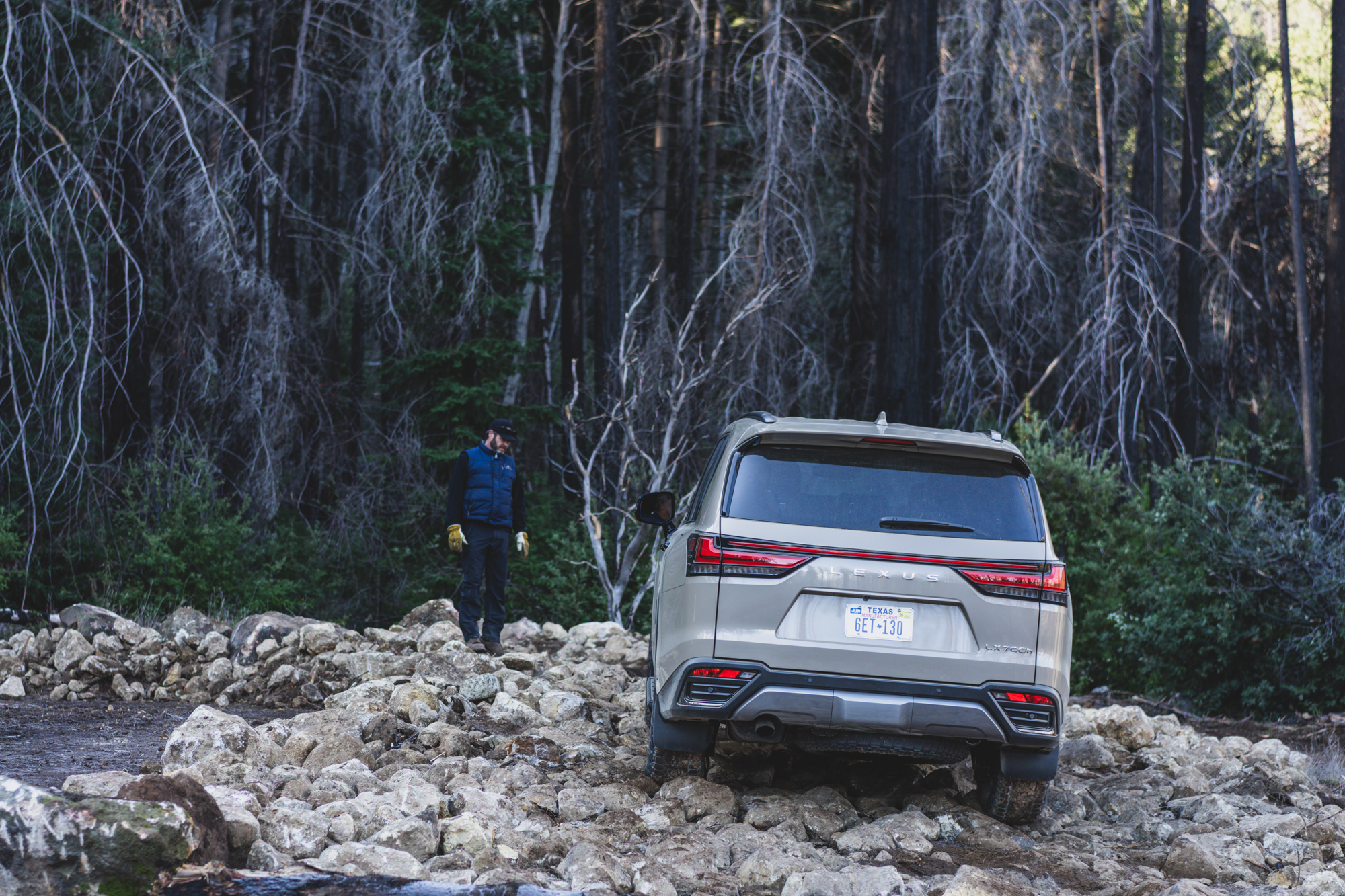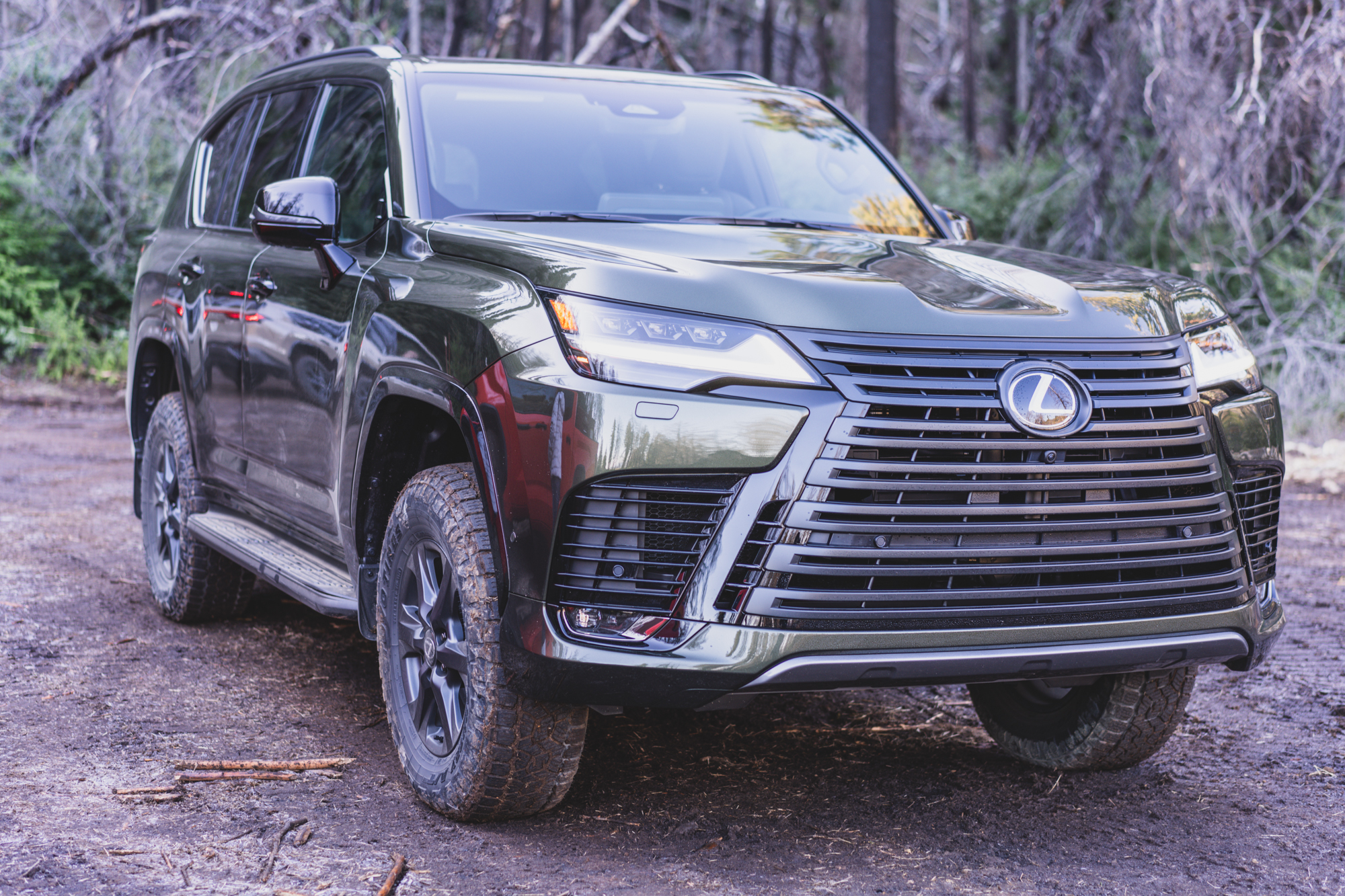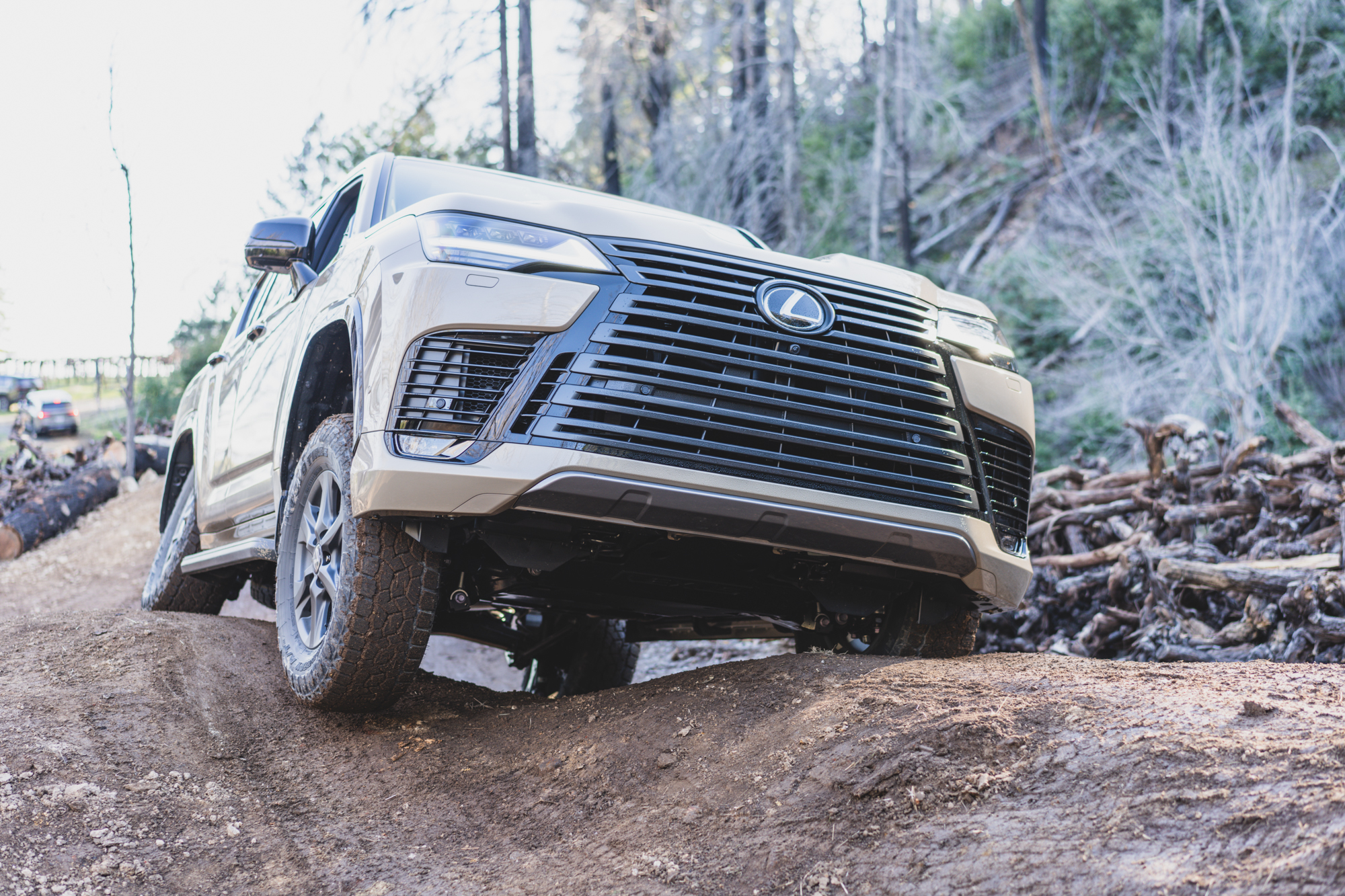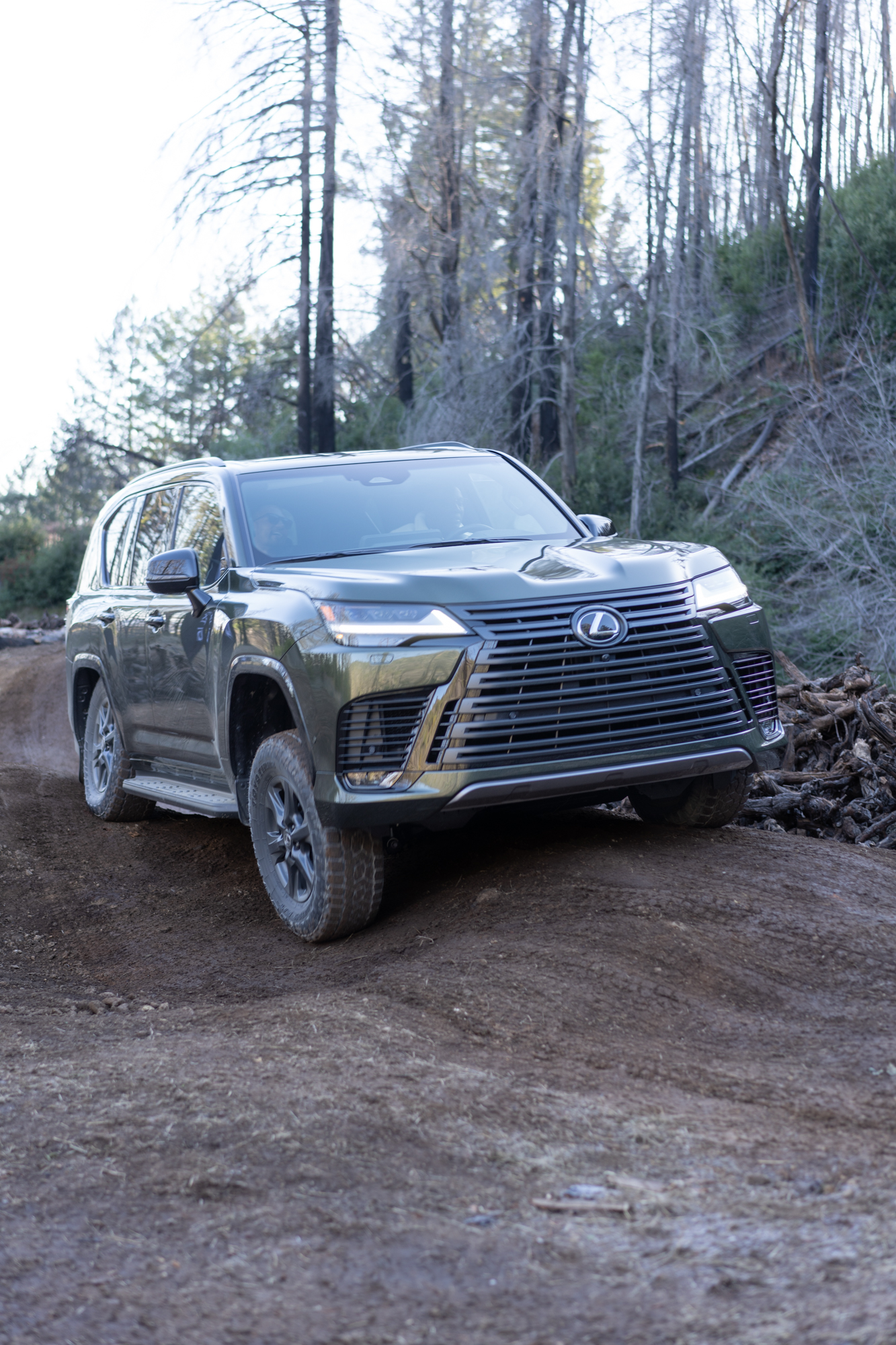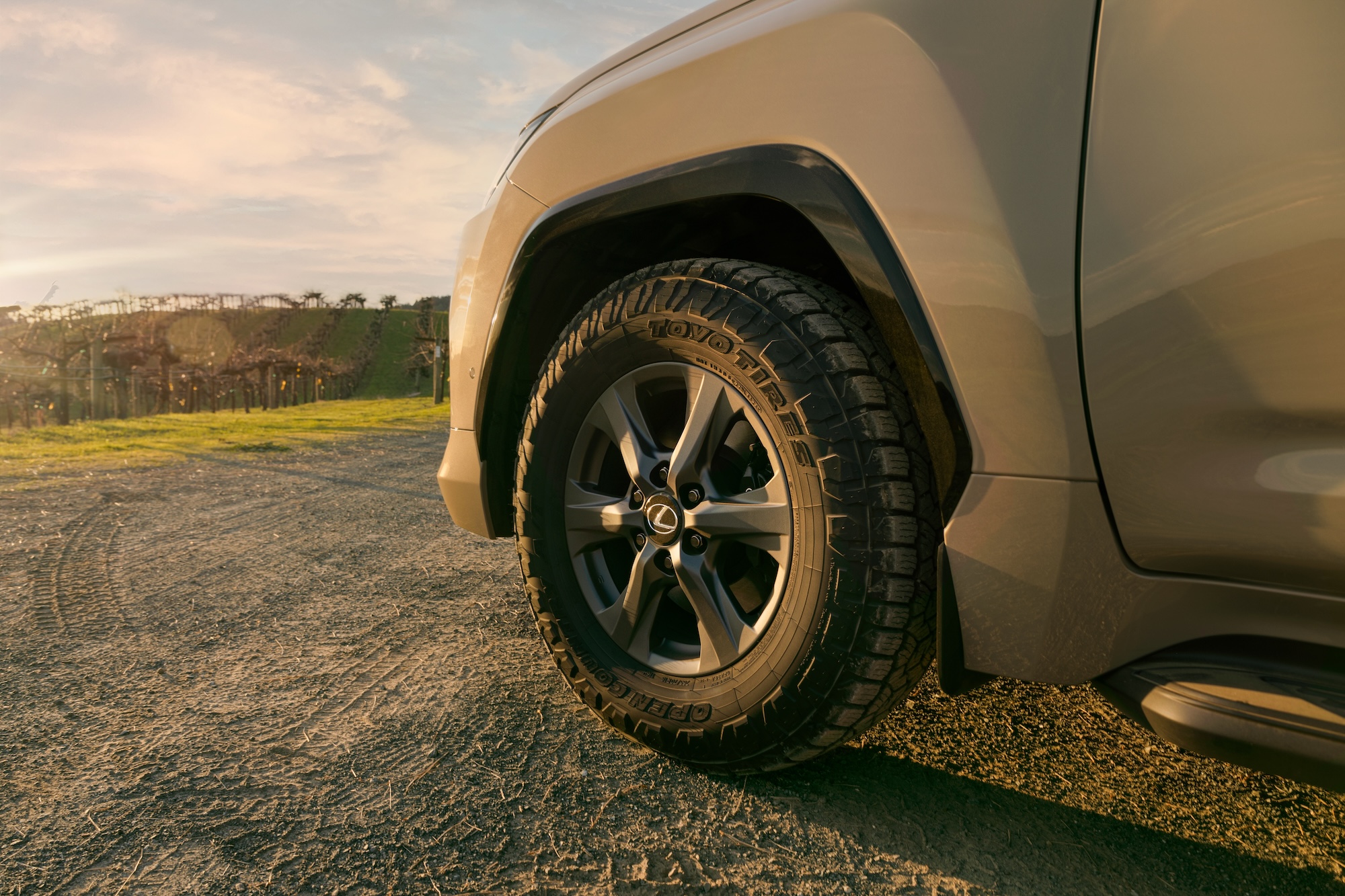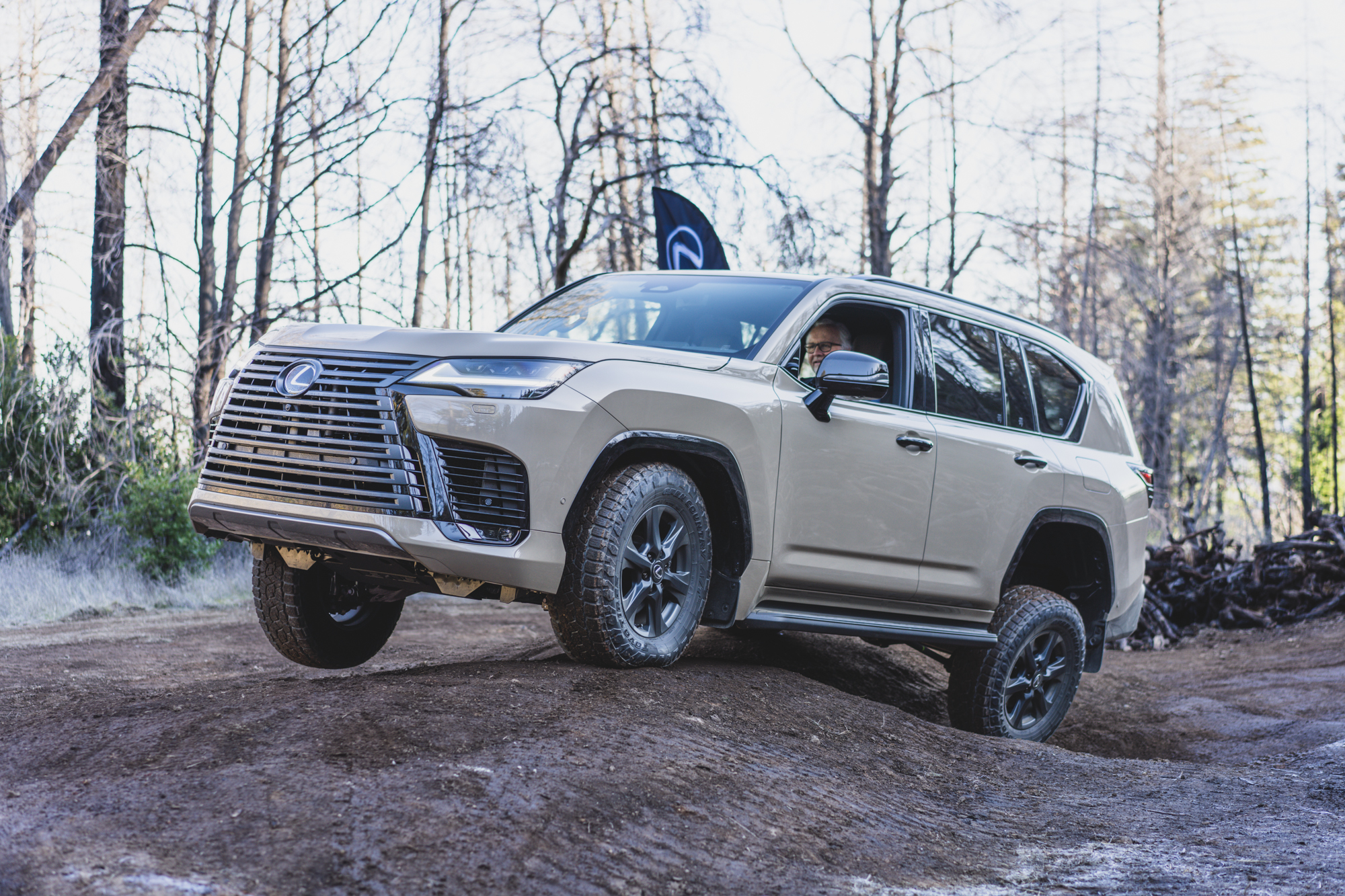Few vehicles capture the spirit of overlanding like a Land Cruiser: rugged, capable, worldly, and trusted. For North America, Land Cruisers have been sold since 1958 and were available as the pinnacle overlander of choice for 62 years until the last Heritage Edition 200 Series left dealer lots in 2020. This left a significant void and little hope the 300 series would ever reach our shores in full overland trim. . . until now with the Lexus LX700 Overtrail.
It is part of my job to test new overland vehicles, but it is not common for me to be surprised by a new model and, even more rarefied, to be delighted. That all changed a few weeks ago when Lexus revealed the new LX700 Overtrail, the closest approximation to a 300 Series GR Land Cruiser we would see in the USA, with even a few pros over the TLC (and a few cons too). Having tested 300 Series Land Cruisers on three continents, the similarities are abundant and in many ways, the Lexus is a better choice for North America. Seeing the tan paint, 18-inch wheels, and 33-inch tires, I couldn’t fight back the grin. I had to resist hollering when the engineer announced that it also had triple differential locks, height-adjustable auto-leveling suspension, a five-passenger model, and multiple durability considerations for remote travel.
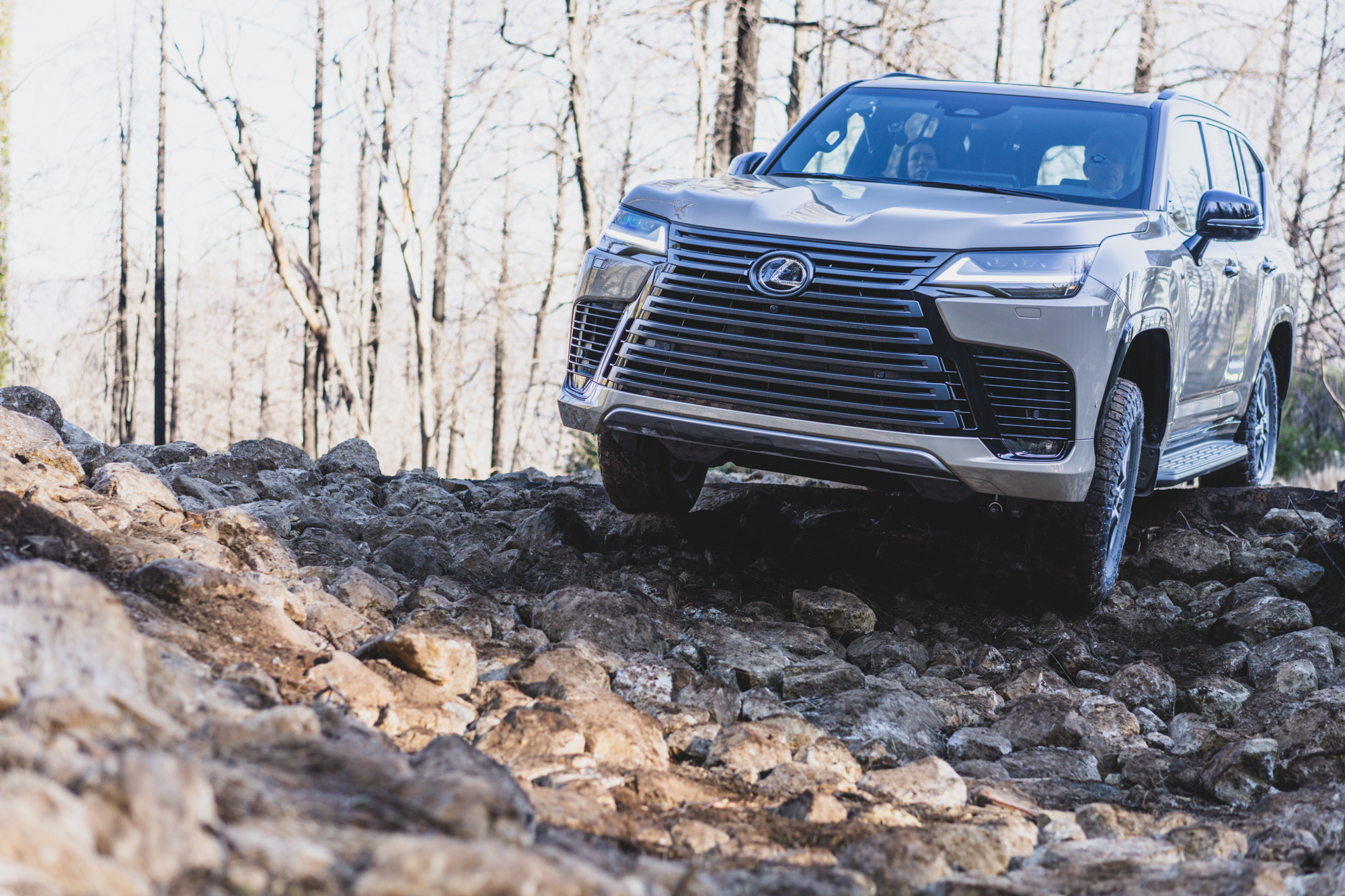
Overland Specifications:
Relying on first impressions with the LX700 would be a mistake. Yes, the grill is still my least favorite attribute of the model, but it hides a lion of overlanding underneath. This starts from the bottom up with the ability to fit an 18-inch wheel (rare in modern SUVs) and 33-inch all-terrain tires (with room for a 35×10.5).
The suspension is one of the best in the segment, retaining ultimate reliability from coil springs yet achieving height and payload adjustability using hydraulically adjustable spring perches. This allows one inch of lowering and four inches of lift from the standard height. H1 can be accessed in high range, lifting the vehicle three inches, and H2 can be selected in low range for a total of four inches higher. An additional .5-1″ can be achieved in an auto-extract mode when the vehicle senses that it is grounded using the height position sensors and wheelspin.
While the coil springs lack some of the NVH benefits of airbags (attenuation), they greatly improve durability and ride quality at higher ride height positions. An airbag achieves height adjustment by using air pressure to lift the chassis, which also changes the spring rate, reducing compliance (compression) and ride quality. The Lexus only changes the spring position relative to the upper coil bucket, which has a nominal effect on rate, retaining compliance, and comfort. It will be possible to swap out the coils for higher spring rates using the aftermarket while still retaining the height adjustability and load leveling- huzzah!
For overlanding, durability and reliability are pillars of the pursuit, which makes a Lexus particularly well suited to the task. For decades, Lexus has maintained a top position in the Consumer Reports reliability verdict, with over double the ratings of Jeep, Ford, and GM. Durability stems from the J300 series Land Cruiser TNGA-F chassis, axles, and transfer case, in addition to being built in the Tahara plant in Japan—all J series Land Cruisers (the LX is known internally as the J310) a built to a 500,000-mile service life.
There are inherent complexities that come with a hybrid system, which their engineering team has worked hard to address by including redundant systems to allow for limp-home if the hybrid powertrain fails. This includes a redundant starter and alternator to supplant the motor/starter/generator. The battery is also in a water-resistant case with a water sensor. The battery box allows the hybrid to keep the same 700mm wading depth as the LX600. In the rare occurrence that the LX700 needs service, the Lexus brand is sold in 90 countries on six continents, and Toyotas are sold in more than 170 countries.
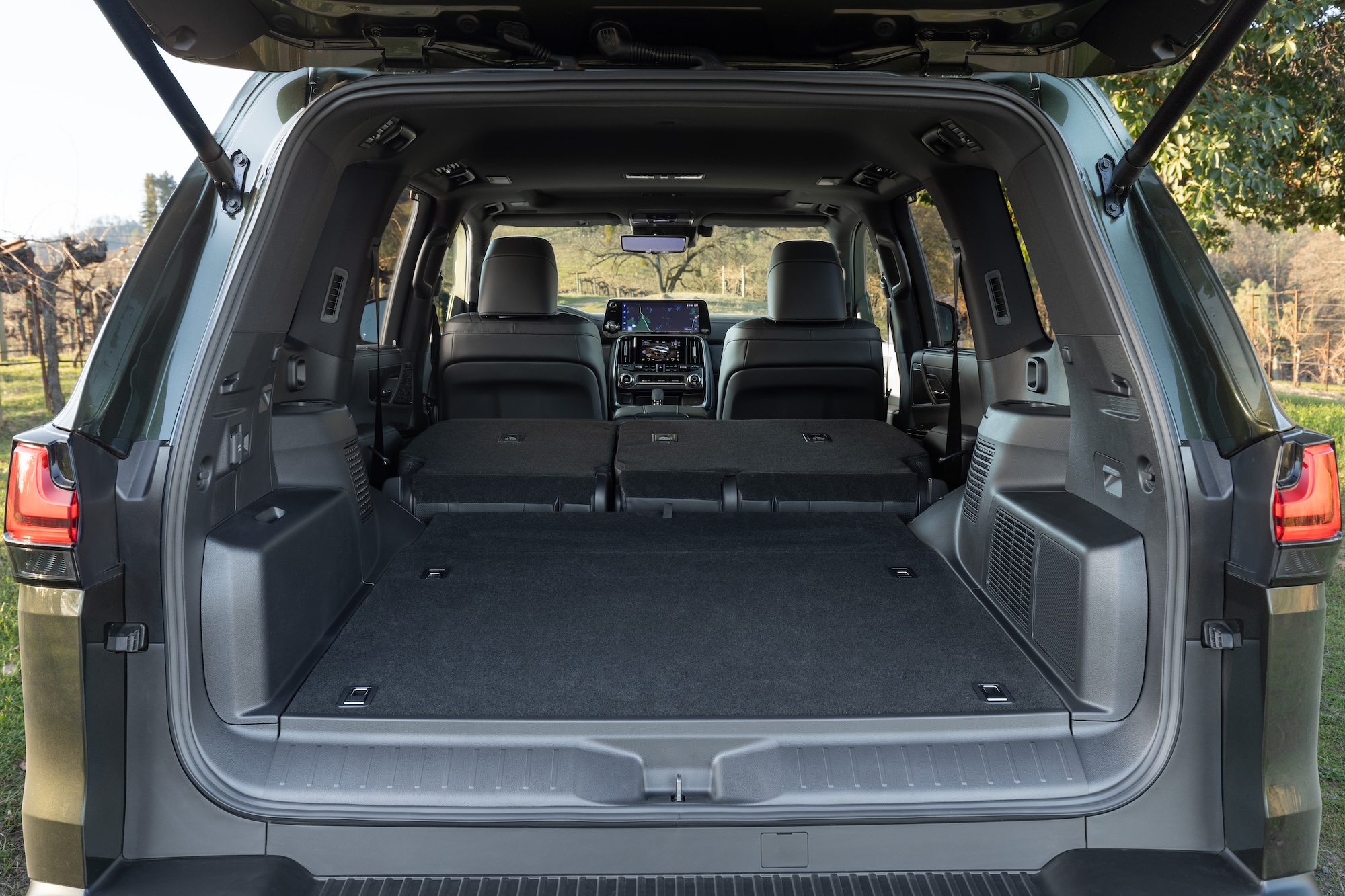
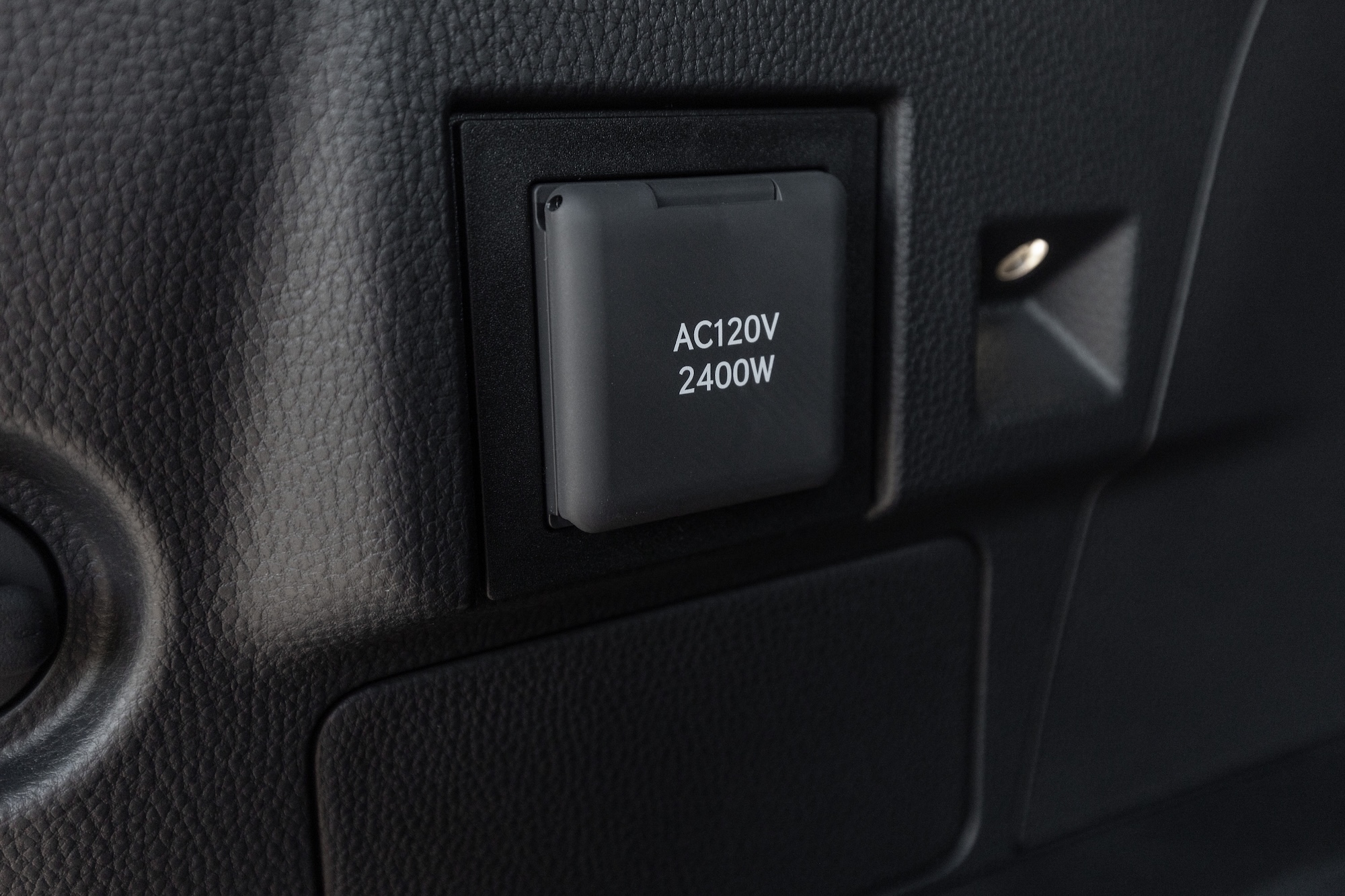
One of the key attributes of an overland vehicle is the payload, and the LX provides a reasonable result at 1190 pounds for the 5-passenger model. For most travelers, that will be sufficient, and the math plays out based on GVWR that the LX700h can have a calculated payload of 1,322 depending on trim. If maximum payload is needed, the LX600 will be a better choice, affording a theoretical 1,476 if equipped properly. Payload becomes particularly troublesome when max towing is considered. For example, an 8,000-pound trailer can easily have a tongue weight of 8-16% (depending on the number of axles) or 640-1,280 pounds. Tongue weighting is a critical consideration when safe towing. I can see numerous scenarios where an LX with even one or two passengers could exceed payload due to drawbar load, even if it doesn’t exceed GCVWR. The payload is adequate, but all factors considered, the Overtrail 5-passenger should have a payload of 1,400-1,600 to accommodate passengers and rated towing (for comparison, the GX J300 has a payload of 1,730 lbs). The roof load rating of the J305 is unavailable, but the 300 Series is rated for 200 pounds (92 kg).
Another key attribute of an overland vehicle is fuel range, and the Overtrail benefits from a reasonable hybrid fuel economy rating of 19 mpg city, but is limited by the 17.9 gallon (67.7 liter) fuel tank. This gives a best-case travel range of around 320 miles. Curiously, the LX600 has a 21.4-gallon fuel tank and only a few mpg difference in economy. An LX should have a 90-95 liter tank like every LX or Land Cruiser before it- it is just best practice.
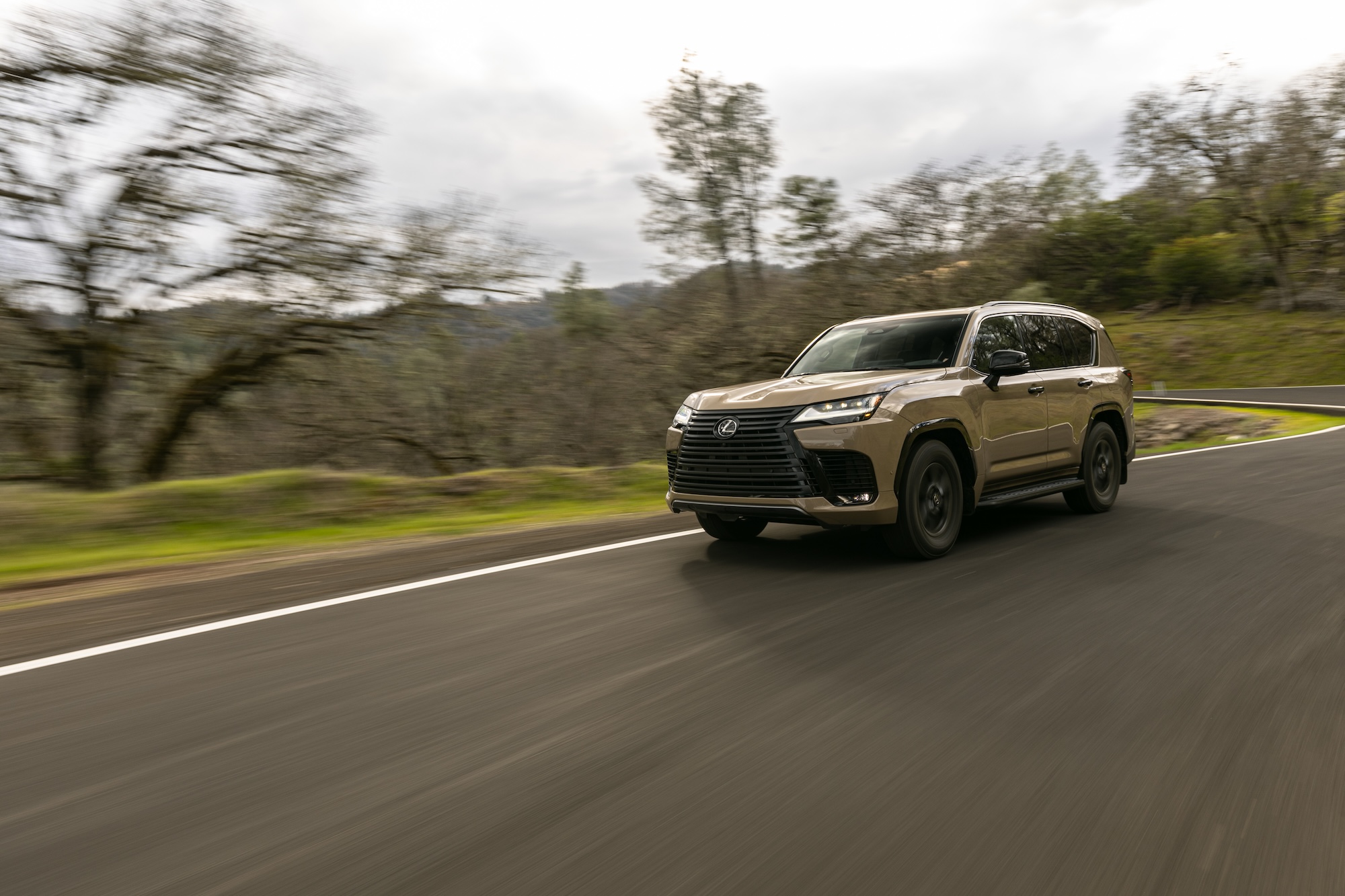
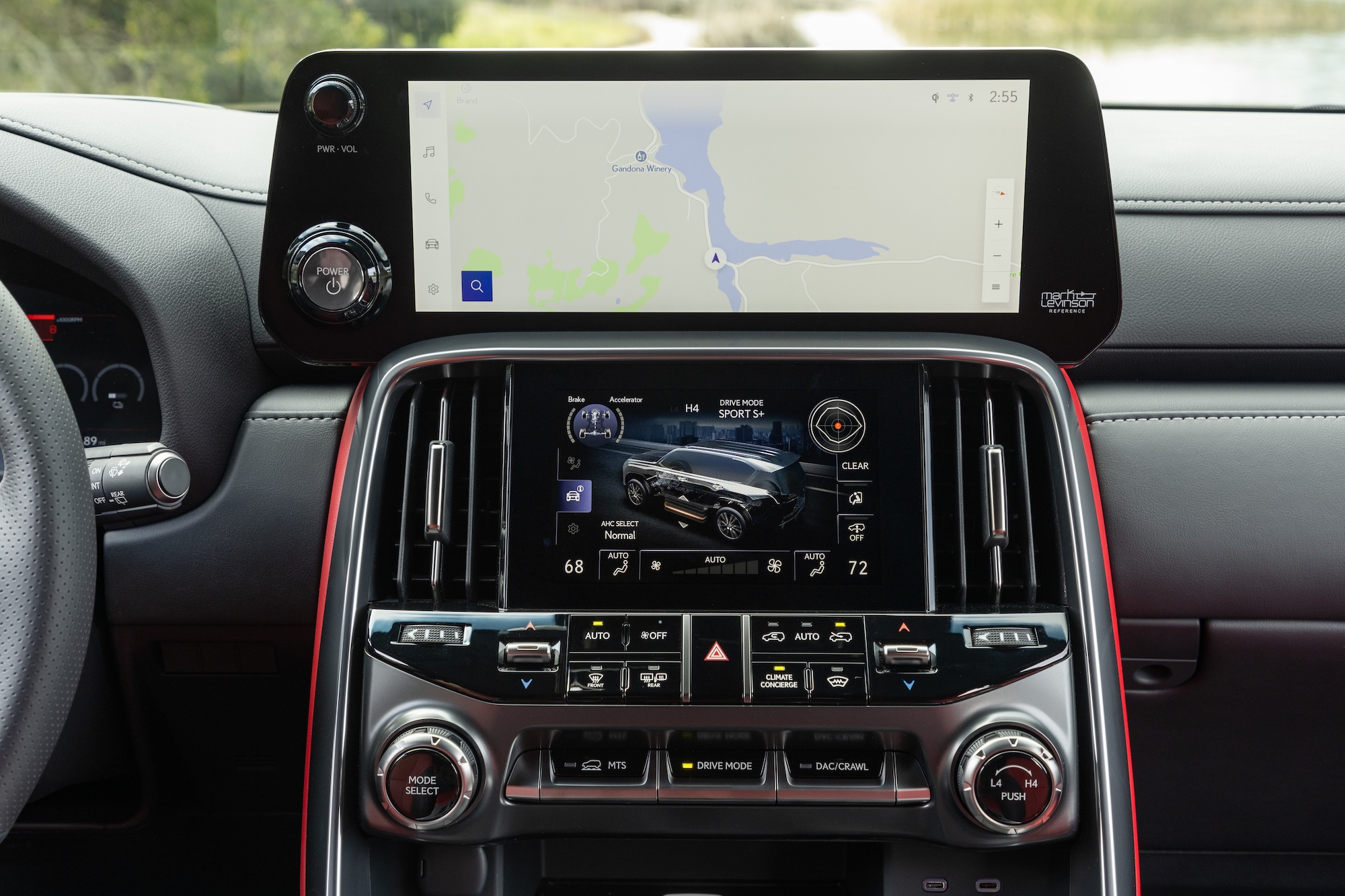
The LX700 is supremely comfortable as a travel vehicle and consumes miles effortlessly. The seats are supportive and comfortable, benefiting from such luxuries as heating, cooling, and massaging. The ride quality is excellent, and the entire experience reflects shockingly low noise, vibration, or harshness (NVH), even with the 33-inch AT tires. I was impressed by the effectiveness of the different drive modes, with sport mode being the best for most road ventures. It downshifted freely, and the steering effort increased nicely (steering a 6,000-pound LX should feel like it). The shocks actively adjust damping to help control pitch and roll, and this continues into larger impact events like water bars and erosion gullies. The system works so effectively that changing any of it out would be a waste (other than the rear coils to increase the spring rate for persistent travel loads). This is one of the most comfortable and low-fatigue travel vehicles we have tested.
Technical Terrain Specifications:
In less than a decade, Lexus has become one of the most effective overland solutions for North American travelers, releasing the Overtrail package in both the GX and LX. These are not just appearance packages, but feature-rich solutions for remote around-the-world travel. Three factors primarily influence technical terrain capability: 1. Traction, 2. Terrain Clearance, and 3. Suspension Effectiveness (which includes articulation).
For traction, the Overtrail addresses the problem in numerous ways, including mechanical and electronic interventions. Traction begins with the tires on the ground, which are 33-inch diameter Toyo Open Country A/Ts mounted to 18-inch aluminum wheels. The tires alone are quite a stretch for the Lexus brand, with an open pattern and heavy siping. Toyos are known for their durability and resistance to chunking and chipping, which makes them perfect for a heavy SUV. While we prefer a 17-inch wheel, the 18 is a reasonable compromise and affords much-improved flotation and deformation over the 20-inch wheels typically spec’ed in the segment. I closely measured the compression and sweep of the 33, and it looks like a 35×10.5 R18 will fit with nominal trimming.
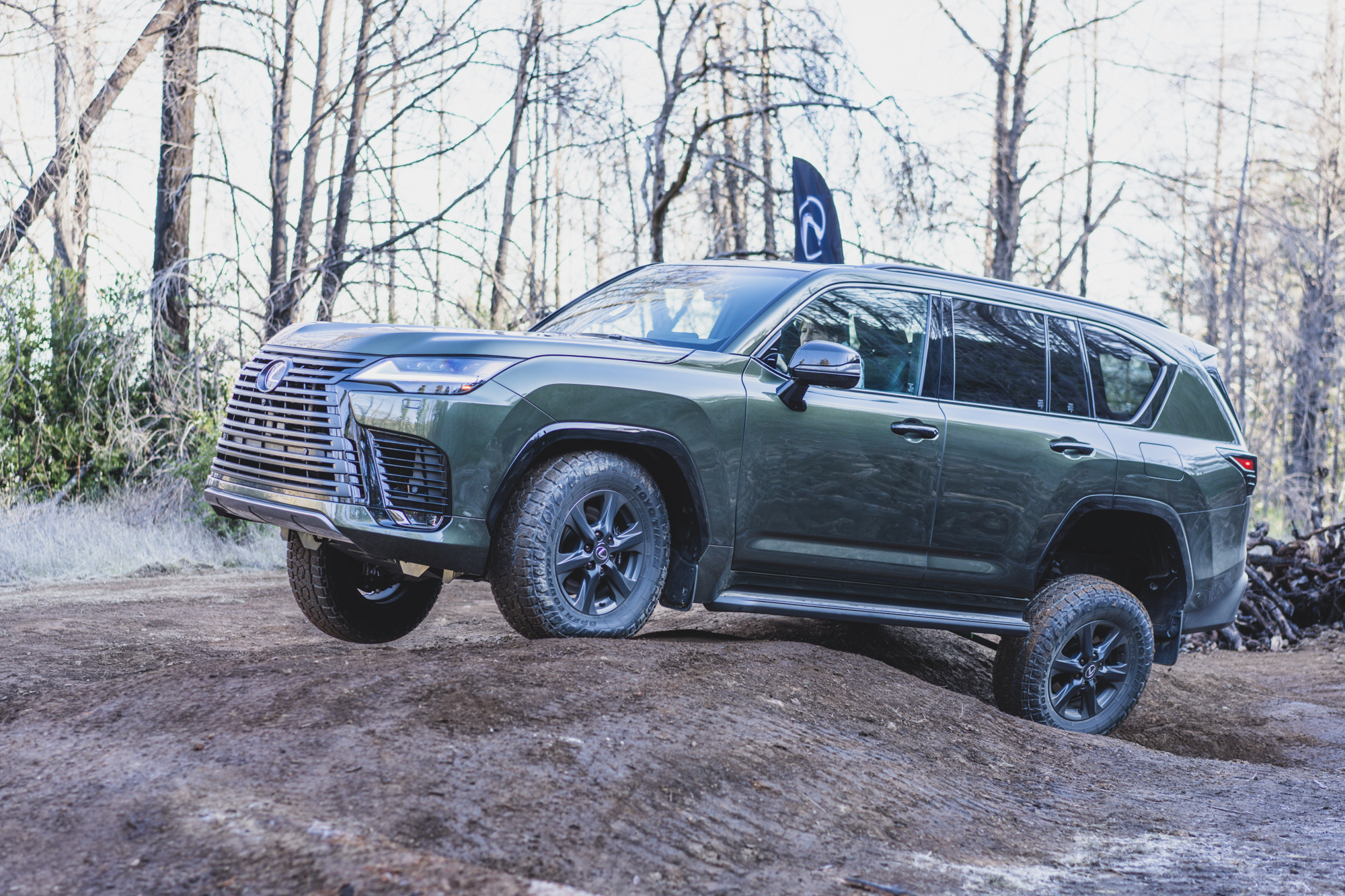
The Overtrail employs triple differential locks and advanced multi-mode traction control to control wheelspin. We have not had triple-differential locks from Toyota in North America since 1997, and I fought every urge not to break into a dance when it was first mentioned at the event. While traction control has improved so much in recent years, it will always be a reactive solution. This creates several problems, including unnecessary trail damage due to wheelspin and the inability to preemptively lock the differential in extreme scenarios where absolute control and line-holding are paramount. Driver-selected differential locks give the operator full agency over the process, including fore-aft and side-to-side wheelspin. For moderate speeds or when understeer is a concern, the center and rear can be locked, and the front can manage wheelspin using traction control. The intervention is near instantaneous in rock mode, often arresting the spinning wheel within a sixteenth of a rotation. What was most impressive was the near-silent operation of the ABS pump and caliper activation. All systems were vastly improved over outgoing crawl control and A-TRAC. The Toyota engineers deserve praise for retaining full traction control intervention and throttle modulation even under heavy left-foot braking.
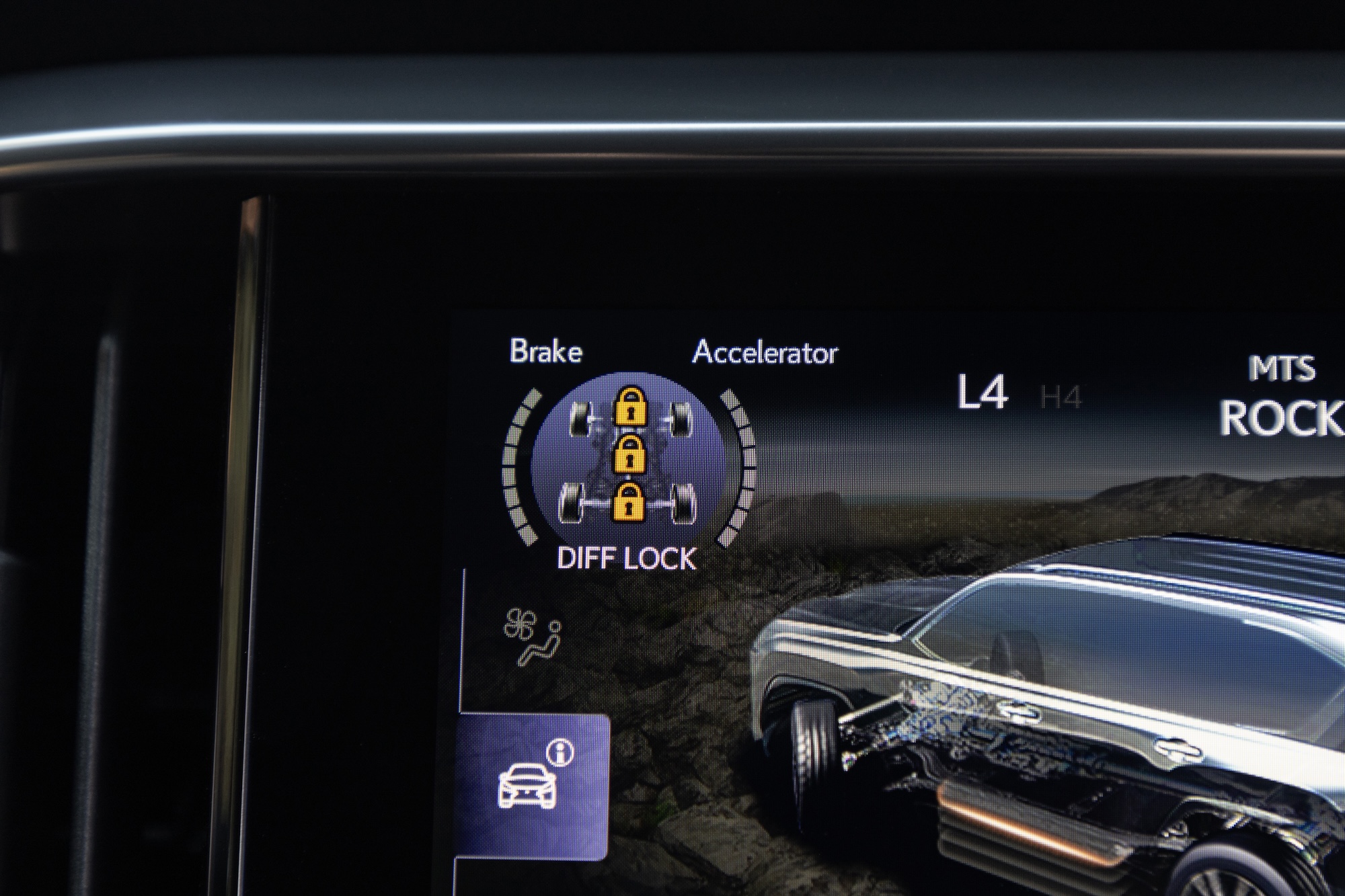
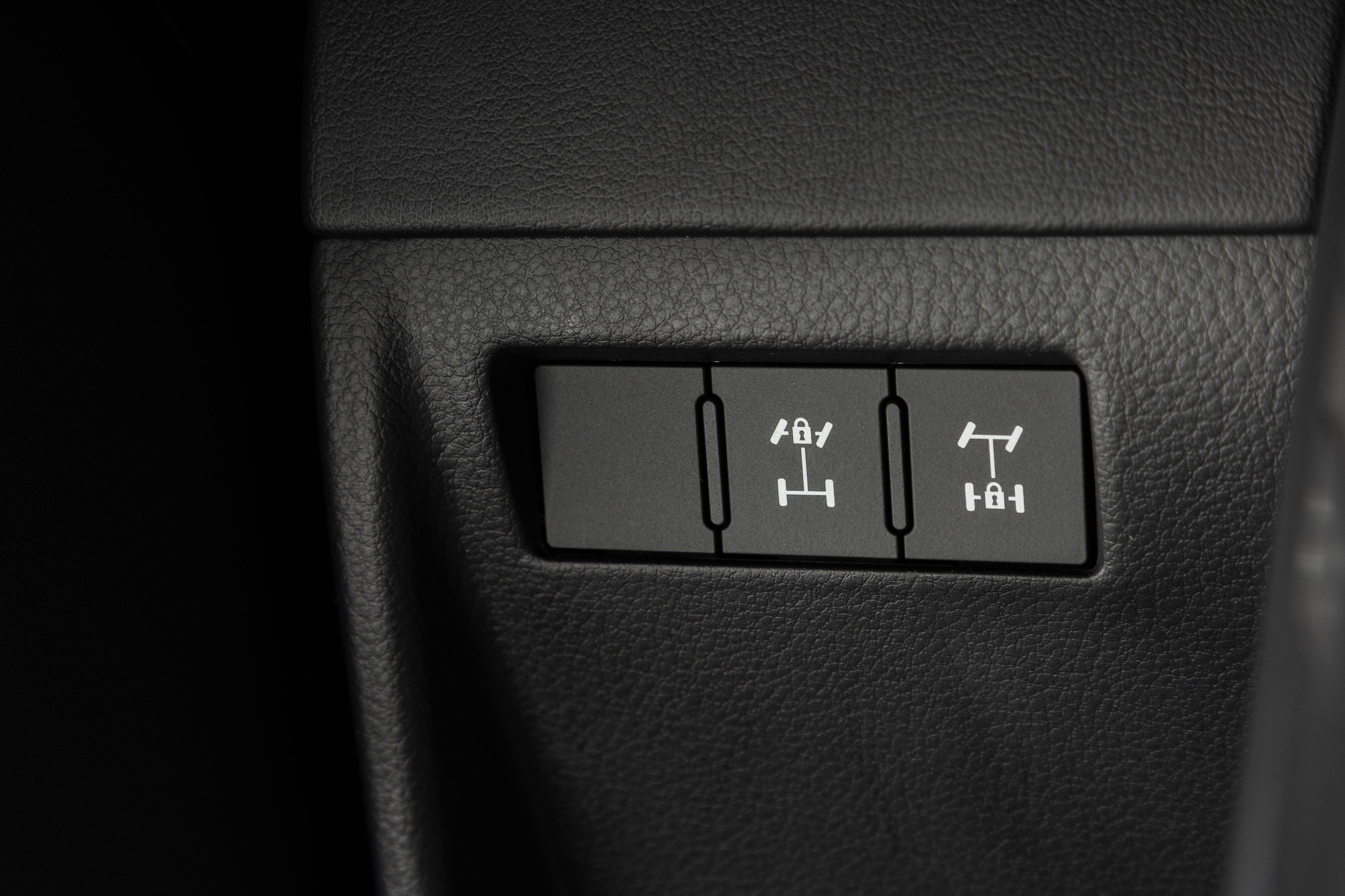
Complementing the excellent traction performance is the LX700h ability to vary ground clearance, maintain tire contact through suspension articulation, and protect the critical components from trail damage. Ground clearance is addressed with both tire diameter and the Active Height Control (AHC) suspension. With a button push, the LX achieves a four-inch lift in Low Range. The shorter 112-inch wheelbase also aids with breakover angle, turning circle, and maneuverability. While the LX is not an FJ40, it has reasonable clearance angles and is competitive against the 200 and 300 Land Cruiser (along with most other manufacturers). The departure angle is the most noticeable during testing and is a packaging compromise. You can’t make a three-row SUV with a 112-inch wheelbase and still have an aggressive departure angle- this was the same issue with the 80, 100, and 200 Land Cruiser. Fortunately, the spare tire helps with that a bit. It is tucked up high in the chassis, but at just the right angle where it works like a “slider” (caution is certainly required). I would add a nodular iron receiver skid for any trail work (like this Total Chaos unit). Overall, skid protection is limited but adequate for the application.
I purposefully attempted every worst-case line I could put the vehicle into on the low-speed technical course—extreme side slopes, forced cross-axle articulation, etc. The LX never balked, even without the lockers engaged. The course was good, but only at 50% of the vehicle’s capability (they need to design courses for vehicle/weather safety and to match the capabilities of a wide range of media drivers). The suspension damping was excellent, demonstrating the low-speed tuning of the shocks to soften the transition from a wheel lift or even help control any wheel lift or suspension lofting (pop). The rear articulation is good, and the front is acceptable, but it is mostly constrained by the front anti-sway bar. It would have been earth-shattering for the LX to gain E-KDSS or even the front swaybar disconnect from the GX/250. The LX is not a rock crawler (it never has been), but it is ready to overcome any reasonable road or trail condition around the world. As one clever feature, the hybrid system will operate in electric-only mode while at low speed in low range. Silence in nature is always a win!
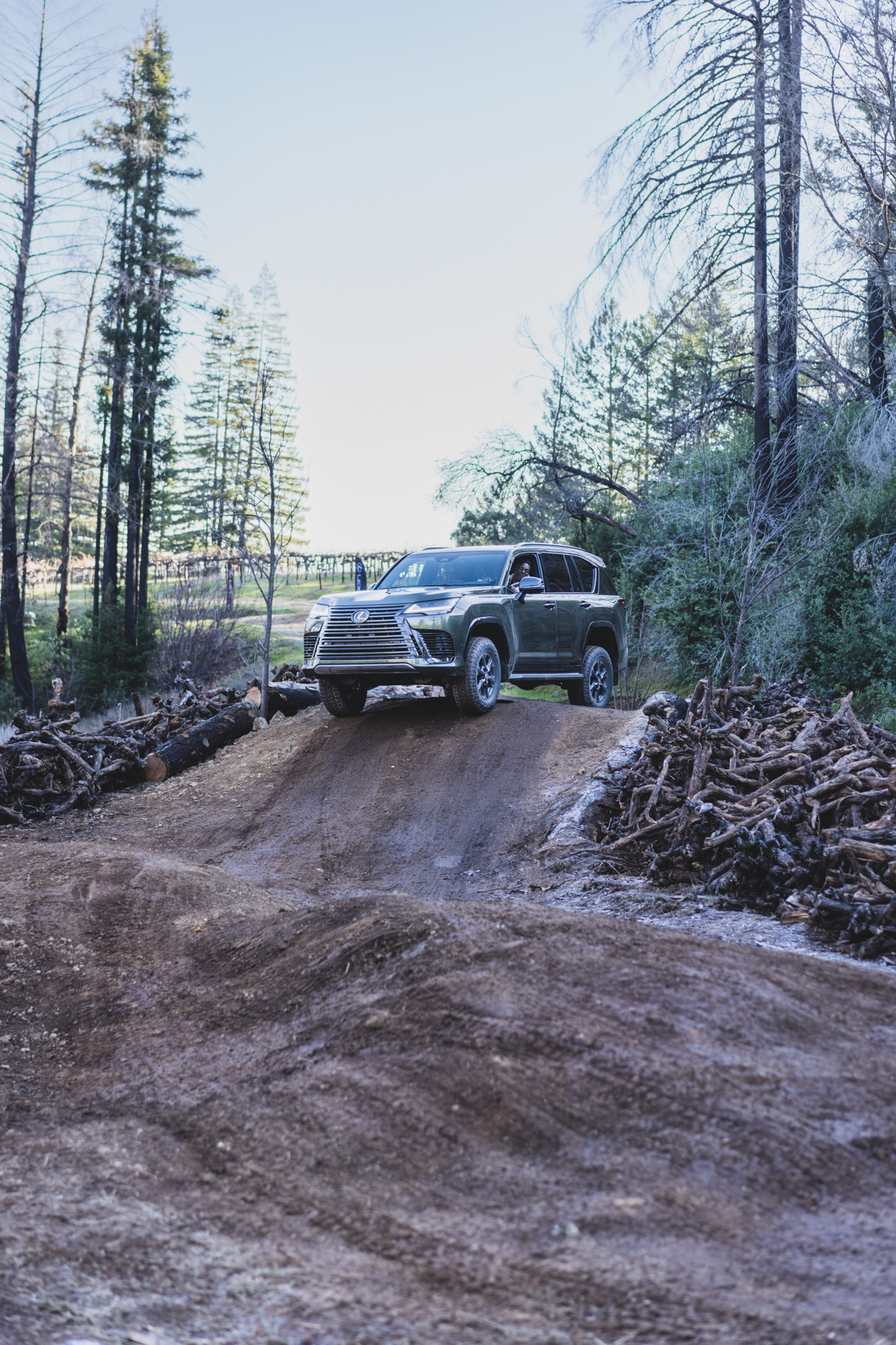
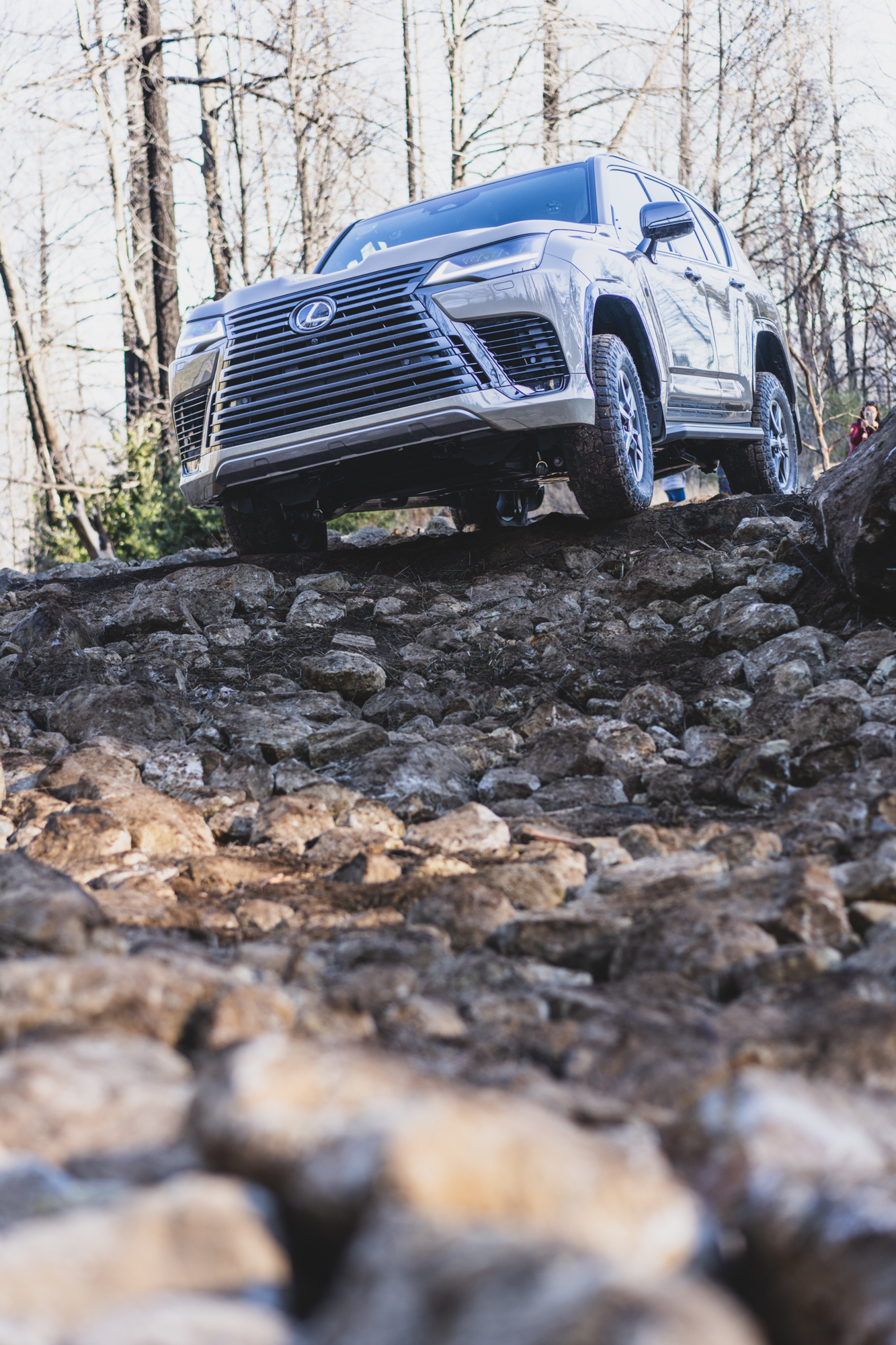
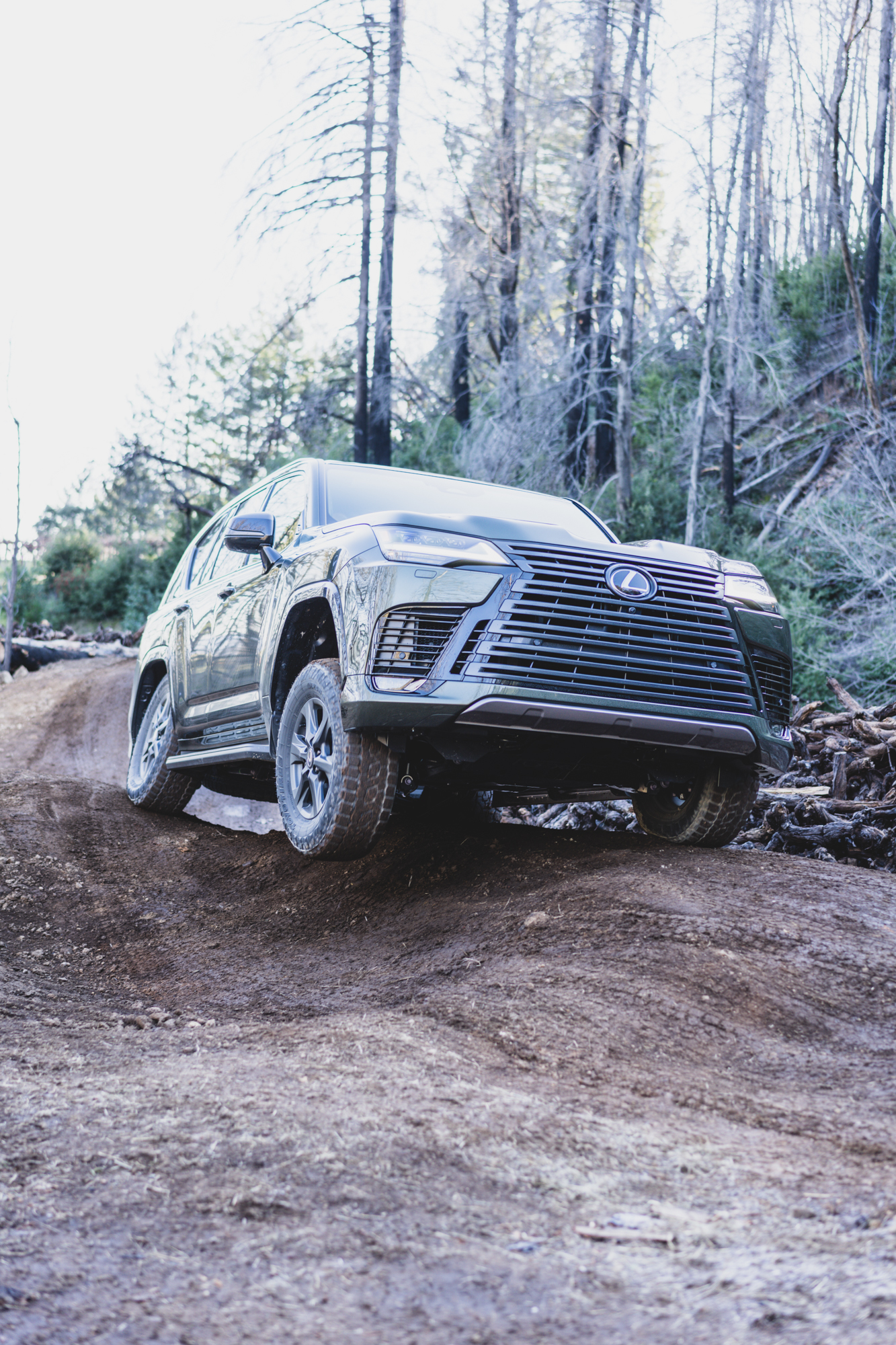
Conclusions:
While it is tempting to wax poetic about my fondness for the LX700 or to reiterate the long list of notable attributes and specifications, I will keep the conclusions simple. The LX700 is one of the finest Lexus overland vehicles ever produced and also one of the finest North American specification overland vehicles- period. The Overtrail is one of the most capable pinnacle overlanders ever brought to the US, and from the most reliable brand globally. I would love to see the LX600 as an overtrail with a higher payload, longer range, and a lower MSRP. The initial investment is the biggest constraint to the LX700h, but the high resale value offsets that. Calculate the total cost of ownership and the value becomes more prescient. The triple-diff-locked J series has returned to the USA- well done, Lexus building the Overtrail as a pinnacle overlander.
lexus.com | $114,000
Pros
Triple differential locks and 33-inch tires on 18-inch wheels
Supremely comfortable travel vehicle
Supremely reliable and durable
Cons
17.9 Gallon Fuel Tank falls below pinnacle vehicle range standards
A payload of 1190 falls below pinnacle vehicle standards
Lacks E-KDSS of the 300
Addressing the Price
I can already hear the comments on the price, but this is 2025, not 1995. Yes, the LX700 costs $114,000, but a 1995 Land Cruiser 80 is an inflation-adjusted $95,868 and has less than half the horsepower, tows 40% less, and uses 40% more fuel. A new 300 series GR Land Cruiser with lockers in Australia costs just over USD $100,000 (not including tax). In Kenya, a 300 series costs $209,000. Quality isn’t cheap, and inflation cuts deep. The Lexus brand has won the KBB resale award for premium SUV for many years, which results in a lower overall cost of ownership than anticipated.
Scott Brady Build Spec:
I have spent a lot of time on the lexus.com builder, and this might prove to be my most expensive test drive in 20 years. The Overtrail is so good that I am considering buying one. This is how I would build my personal Lexus Overtail Overlander.
LX 700h Overtrail
-Eminent Pearl White: +$500
-Stone Brown Interior: Included
-18-inch Matte Grey Aluminum Wheels: Included
– Seating for Five: -$1,750 (savings in both cost and payload)
Total Price Including Delivery, Processing, and Handling: $114,100
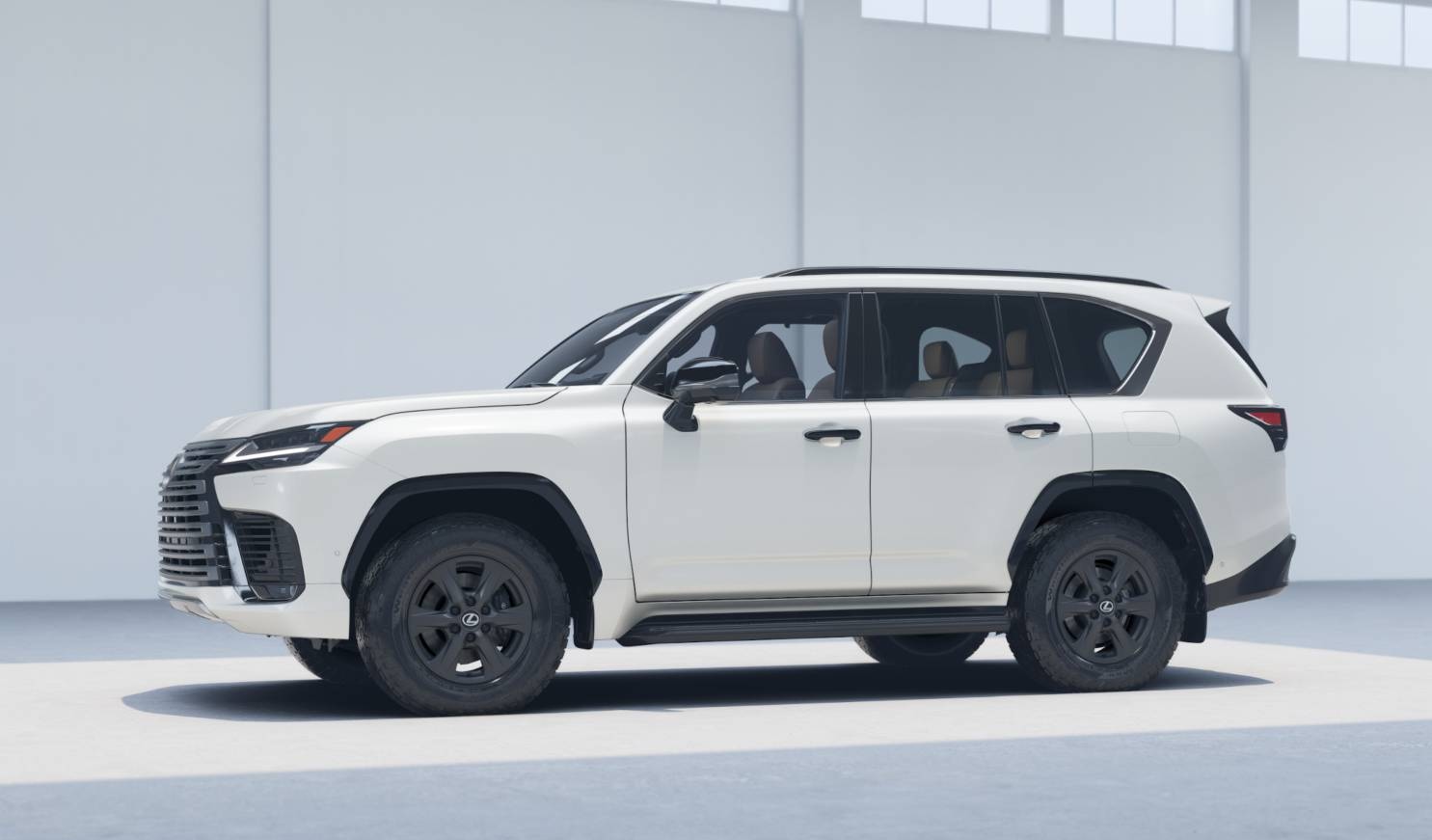
Images: Lexus, Scott Brady
Read more: Lexus Announces Upgrades to the LH 700h, LX 600, and the Overtrail Grades
Our No Compromise Clause: We do not accept advertorial content or allow advertising to influence our coverage, and our contributors are guaranteed editorial independence. Overland International may earn a small commission from affiliate links included in this article. We appreciate your support.
